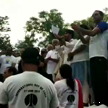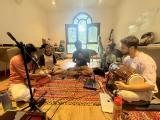
Platinum
Chhattarpur, Delhi, India - 110074.
82
Details verified of Bhuvnesh Dutt✕
 Identity
Identity
 Education
Education
Know how UrbanPro verifies Tutor details
Identity is verified based on matching the details uploaded by the Tutor with government databases.





Hindi Mother Tongue (Native)
English Proficient
Punjabi Proficient
![]() DELHI UNIVERSITY 2021
DELHI UNIVERSITY 2021
Bachelor of Arts (B.A.)
 SAPTAKK KALA KENDRA 2018
SAPTAKK KALA KENDRA 2018
3 YRARS OF CLASSICAL VOCAL TRAINING
 PRAYAG SANGEET SAMITI 2019
PRAYAG SANGEET SAMITI 2019
PRAYAG SANGEET SAMITI JR DIPLOMA
Chhattarpur, Delhi, India - 110074
![]() ID Verified
ID Verified
![]() Phone Verified
Phone Verified
![]() Email Verified
Email Verified
Report this Profile
Is this listing inaccurate or duplicate? Any other problem?
Please tell us about the problem and we will fix it.
+10 more
Class Location
![]() Online (video chat via skype, google hangout etc)
Online (video chat via skype, google hangout etc)
![]() Student's Home
Student's Home
![]() Tutor's Home
Tutor's Home
Years of Experience in Guitar Classes
4
Genre of guitars taught
Acoustic, Other, Classical
Age groups catered to
Above 25 yrs, 10 yrs to 15 yrs, 16 yrs to 25 yrs, Below 10 yrs
Type of classes
Individual classes, Group classes
Music genres taught
Indian Film music, Indian classical, Western Classical
Outcomes catered to
Learn a specific song, Learn to play as an accompaniment to singing, Learn specific skills: Plucking, Chord progression etc, Learn basics of playing a guitar
Ownership of equipment is compulsory
Yes
Class Location
![]() Online (video chat via skype, google hangout etc)
Online (video chat via skype, google hangout etc)
![]() Student's Home
Student's Home
![]() Tutor's Home
Tutor's Home
Years of Experience in Harmonium Classes
7
Age groups catered to
Above 25 yrs, 10 yrs to 15 yrs, 16 yrs to 25 yrs, Below 10 yrs
Class strength catered to
Group Classes, One on one/ Private Tutions
Class Location
![]() Online (video chat via skype, google hangout etc)
Online (video chat via skype, google hangout etc)
![]() Student's Home
Student's Home
![]() Tutor's Home
Tutor's Home
Years of Experience in Vocal Music classes
7
Gender of teacher
Male tutor
Vocal Style taught
Bhajan Singing, Folk Singing, Hindustani Singing
Age group catered to
14- 21 years old, 2- 5 years-old, 5- 13 years-old, 22- 50 years old, Above 50 years
Class strength catered to
Group Classes, One on one/ Private Tutions
Proficiency level catered to
Intermediate, Beginner
Class Location
![]() Online (video chat via skype, google hangout etc)
Online (video chat via skype, google hangout etc)
![]() Student's Home
Student's Home
![]() Tutor's Home
Tutor's Home
Years of Experience in Keyboard (Music) Classes
7
Age groups catered to
Above 25 yrs, 10 yrs to 15 yrs, 16 yrs to 25 yrs, Below 10 yrs
Class strength catered to
Group Classes, One on one/ Private Tutions
1. What genre of guitar do you teach ?
Acoustic, Other and Classical
2. Do I need to bring my own equipment?
Yes
3. Which classes do you teach?
I teach Guitar, Harmonium, Keyboard (Music) and Vocal Music Classes.
4. Do you provide a demo class?
Yes, I provide a free demo class.
5. How many years of experience do you have?
I have been teaching for 4 years.
Answered 1 day ago Learn Music/Instrumental Music/Indian Instrumental Music/Mridangam
Pakhawaj and Mridangam are both ancient Indian percussion instruments, but they have distinct differences:
*Physical Differences:*
1. Shape: Pakhawaj - cylindrical, Mridangam - barrel-shaped
2. Size: Pakhawaj - typically longer (25-30 inches), Mridangam - shorter (22-25 inches)
3. Material: Both - wood or fiber, but Pakhawaj often has a thicker shell
*Sound Differences:*
1. Tone: Pakhawaj - deeper, more resonant, Mridangam - sharper, more crisp
2. Pitch: Pakhawaj - lower pitched, Mridangam - higher pitched
3. Sonic range: Pakhawaj - wider dynamic range
*Playing Style Differences:*
1. Stroke patterns: Pakhawaj - emphasizes bold, powerful strokes, Mridangam - intricate finger movements
2. Syllable patterns (bols): Pakhawaj - uses distinct bols, Mridangam - uses more complex bols
3. Technique: Pakhawaj - focuses on palm strokes, Mridangam - emphasizes finger strokes
*Cultural and Musical Differences:*
1. Tradition: Pakhawaj - associated with Hindustani classical, Mridangam - associated with Carnatic classical
2. Region: Pakhawaj - originated in North India, Mridangam - originated in South India
3. Musical context: Pakhawaj - often accompanies vocal and instrumental music, Mridangam - integral to Carnatic music ensembles
*Other Key Differences:*
1. Tuning: Pakhawaj - tuned to a specific pitch, Mridangam - tuned to multiple pitches
2. Head material: Pakhawaj - often uses goat skin, Mridangam - uses cow skin or synthetic materials
These differences reflect the unique characteristics and roles of each instrument in Indian classical music traditions.
Answered 1 day ago Learn Music/Instrumental Music/Indian Instrumental Music/Mridangam
Playing the mridangam poses technical, physical, and musical challenges:
Technical Challenges:
1. Complex finger movements and strokes
2. Intricate syllable patterns (bols)
3. Maintaining precise rhythm and timing
4. Mastering various tonal variations and dynamics
5. Coordinating left and right hand strokes
Physical Challenges:
1. Building finger strength, endurance, and dexterity
2. Developing calluses and protecting hands from injury
3. Maintaining proper posture and hand positioning
4. Managing fatigue during extended performances
Musical Challenges:
1. Understanding complex ragas and taal cycles
2. Developing musical expression and nuance
3. Improvising and responding to melodic instruments
4. Balancing accompaniment and solo playing
5. Adapting to different musical styles and genres
Practice and Performance Challenges:
1. Finding qualified teachers and guidance
2. Accessing quality instruments and maintenance
3. Overcoming stage fright and performance anxiety
4. Collaborating with other musicians and adapting to ensemble dynamics
Cultural and Traditional Challenges:
1. Preserving traditional playing styles and techniques
2. Innovating within established musical frameworks
3. Bridging cultural and generational gaps
4. Respecting lineage and guru-shishya parampara (teacher-student tradition)
By acknowledging these challenges, mridangam players can better prepare themselves for the dedication, hard work, and passion required to master this revered instrument.
Answered 1 day ago Learn Music/Instrumental Music/Indian Instrumental Music/Mridangam
Despite differences, these three iconic Indian percussion instruments share similarities:
*Commonalities:*
1. Hand-played: All three instruments are played with hands.
2. Double-headed: Each instrument has two heads, providing varied tonal possibilities.
3. Rhythmic foundation: All provide rhythmic foundation in Indian classical, folk, and fusion music.
4. Syllabic language: Each instrument uses unique syllables (bols) to create rhythmic patterns.
5. Complex fingerwork: Intricate finger movements and strokes create complex rhythms.
6. Cultural significance: Deeply rooted in Indian culture, mythology, and tradition.
7. Improvisation: All three instruments allow for spontaneous improvisation.
*Shared Techniques:*
1. Stroke patterns (e.g., thumb, index, middle finger strokes)
2. Finger independence and coordination
3. Palm strokes and heel-toe techniques
4. Articulation and tonal control
*Musical Contexts:*
1. Accompanying melodic instruments (e.g., sitar, flute)
2. Solo performances and percussion ensembles
3. Devotional and spiritual music
4. Folk and traditional music
*Shared Materials:*
1. Wooden shells (some modern variations use fiber or synthetic materials)
2. Animal skin or synthetic heads
*Unifying Spirit:*
1. Connecting people through rhythm and music
2. Preserving cultural heritage and traditions
3. Inspiring creativity and self-expression
These similarities highlight the shared essence and rich cultural significance of the dholak, mridangam, and tabla in Indian music and beyond.
Answered 1 day ago Learn Music/Instrumental Music/Indian Instrumental Music/Mridangam
The Dholak serves multiple purposes across various cultural and musical contexts:
*Traditional and Cultural Significance:*
1. Accompanying folk songs and dances
2. Providing rhythmic support in classical music
3. Participating in devotional and spiritual events
4. Enhancing wedding and festival celebrations
*Musical Functions:*
1. Timekeeping: Maintaining rhythm and tempo
2. Rhythmic accompaniment: Supporting melodic instruments
3. Solo performances: Showcasing technical skill and musicality
4. Improvisation: Creating dynamic, spontaneous rhythms
*Social and Community Roles:*
1. Bringing people together through music and dance
2. Preserving cultural heritage and traditions
3. Providing entertainment and enjoyment
4. Facilitating social bonding and community engagement
*Therapeutic and Educational Benefits:*
1. Stress relief and relaxation through rhythmic expression
2. Developing hand-eye coordination and motor skills
3. Improving cognitive abilities through rhythmic patterns
4. Teaching cultural values and traditions to younger generations
*Contemporary Uses:*
1. Fusion music and experimental collaborations
2. Film and television soundtracks
3. Live performances and concerts
4. Music therapy and wellness programs
The Dholak's versatility and rich cultural significance make it an integral part of various aspects of life, from traditional music to social gatherings and personal growth.
Answered 1 day ago Learn Music/Instrumental Music/Indian Instrumental Music/Mridangam
A subjective question!
Dholak is an excellent instrument, but "best" depends on personal taste, cultural context, and musical genre. Here's why:
_Unique strengths:_
1. Versatility: Dholak adapts to various musical styles and genres.
2. Expressiveness: Its dynamic range and tonal variations evoke emotions.
3. Accessibility: Relatively easy to learn and play.
_Other excellent percussion instruments:_
1. Tabla: Renowned for its intricate finger work and complex rhythms.
2. Mridangam: Offers deep, resonant tones and intricate playing techniques.
3. Pakhawaj: Provides rich, powerful sound and complex rhythmic patterns.
_Consider the context:_
1. Cultural significance: Each instrument has its own cultural and historical importance.
2. Musical genre: Different instruments suit specific genres (e.g., classical, folk, fusion).
3. Personal preference: Ultimately, the "best" instrument is one that resonates with you.
In conclusion, while Dholak is an amazing instrument, "best" is subjective. Explore various instruments, find what resonates with you, and enjoy the rich world of percussion!
Class Location
![]() Online (video chat via skype, google hangout etc)
Online (video chat via skype, google hangout etc)
![]() Student's Home
Student's Home
![]() Tutor's Home
Tutor's Home
Years of Experience in Guitar Classes
4
Genre of guitars taught
Acoustic, Other, Classical
Age groups catered to
Above 25 yrs, 10 yrs to 15 yrs, 16 yrs to 25 yrs, Below 10 yrs
Type of classes
Individual classes, Group classes
Music genres taught
Indian Film music, Indian classical, Western Classical
Outcomes catered to
Learn a specific song, Learn to play as an accompaniment to singing, Learn specific skills: Plucking, Chord progression etc, Learn basics of playing a guitar
Ownership of equipment is compulsory
Yes
Class Location
![]() Online (video chat via skype, google hangout etc)
Online (video chat via skype, google hangout etc)
![]() Student's Home
Student's Home
![]() Tutor's Home
Tutor's Home
Years of Experience in Harmonium Classes
7
Age groups catered to
Above 25 yrs, 10 yrs to 15 yrs, 16 yrs to 25 yrs, Below 10 yrs
Class strength catered to
Group Classes, One on one/ Private Tutions
Class Location
![]() Online (video chat via skype, google hangout etc)
Online (video chat via skype, google hangout etc)
![]() Student's Home
Student's Home
![]() Tutor's Home
Tutor's Home
Years of Experience in Vocal Music classes
7
Gender of teacher
Male tutor
Vocal Style taught
Bhajan Singing, Folk Singing, Hindustani Singing
Age group catered to
14- 21 years old, 2- 5 years-old, 5- 13 years-old, 22- 50 years old, Above 50 years
Class strength catered to
Group Classes, One on one/ Private Tutions
Proficiency level catered to
Intermediate, Beginner
Class Location
![]() Online (video chat via skype, google hangout etc)
Online (video chat via skype, google hangout etc)
![]() Student's Home
Student's Home
![]() Tutor's Home
Tutor's Home
Years of Experience in Keyboard (Music) Classes
7
Age groups catered to
Above 25 yrs, 10 yrs to 15 yrs, 16 yrs to 25 yrs, Below 10 yrs
Class strength catered to
Group Classes, One on one/ Private Tutions
Answered 1 day ago Learn Music/Instrumental Music/Indian Instrumental Music/Mridangam
Pakhawaj and Mridangam are both ancient Indian percussion instruments, but they have distinct differences:
*Physical Differences:*
1. Shape: Pakhawaj - cylindrical, Mridangam - barrel-shaped
2. Size: Pakhawaj - typically longer (25-30 inches), Mridangam - shorter (22-25 inches)
3. Material: Both - wood or fiber, but Pakhawaj often has a thicker shell
*Sound Differences:*
1. Tone: Pakhawaj - deeper, more resonant, Mridangam - sharper, more crisp
2. Pitch: Pakhawaj - lower pitched, Mridangam - higher pitched
3. Sonic range: Pakhawaj - wider dynamic range
*Playing Style Differences:*
1. Stroke patterns: Pakhawaj - emphasizes bold, powerful strokes, Mridangam - intricate finger movements
2. Syllable patterns (bols): Pakhawaj - uses distinct bols, Mridangam - uses more complex bols
3. Technique: Pakhawaj - focuses on palm strokes, Mridangam - emphasizes finger strokes
*Cultural and Musical Differences:*
1. Tradition: Pakhawaj - associated with Hindustani classical, Mridangam - associated with Carnatic classical
2. Region: Pakhawaj - originated in North India, Mridangam - originated in South India
3. Musical context: Pakhawaj - often accompanies vocal and instrumental music, Mridangam - integral to Carnatic music ensembles
*Other Key Differences:*
1. Tuning: Pakhawaj - tuned to a specific pitch, Mridangam - tuned to multiple pitches
2. Head material: Pakhawaj - often uses goat skin, Mridangam - uses cow skin or synthetic materials
These differences reflect the unique characteristics and roles of each instrument in Indian classical music traditions.
Answered 1 day ago Learn Music/Instrumental Music/Indian Instrumental Music/Mridangam
Playing the mridangam poses technical, physical, and musical challenges:
Technical Challenges:
1. Complex finger movements and strokes
2. Intricate syllable patterns (bols)
3. Maintaining precise rhythm and timing
4. Mastering various tonal variations and dynamics
5. Coordinating left and right hand strokes
Physical Challenges:
1. Building finger strength, endurance, and dexterity
2. Developing calluses and protecting hands from injury
3. Maintaining proper posture and hand positioning
4. Managing fatigue during extended performances
Musical Challenges:
1. Understanding complex ragas and taal cycles
2. Developing musical expression and nuance
3. Improvising and responding to melodic instruments
4. Balancing accompaniment and solo playing
5. Adapting to different musical styles and genres
Practice and Performance Challenges:
1. Finding qualified teachers and guidance
2. Accessing quality instruments and maintenance
3. Overcoming stage fright and performance anxiety
4. Collaborating with other musicians and adapting to ensemble dynamics
Cultural and Traditional Challenges:
1. Preserving traditional playing styles and techniques
2. Innovating within established musical frameworks
3. Bridging cultural and generational gaps
4. Respecting lineage and guru-shishya parampara (teacher-student tradition)
By acknowledging these challenges, mridangam players can better prepare themselves for the dedication, hard work, and passion required to master this revered instrument.
Answered 1 day ago Learn Music/Instrumental Music/Indian Instrumental Music/Mridangam
Despite differences, these three iconic Indian percussion instruments share similarities:
*Commonalities:*
1. Hand-played: All three instruments are played with hands.
2. Double-headed: Each instrument has two heads, providing varied tonal possibilities.
3. Rhythmic foundation: All provide rhythmic foundation in Indian classical, folk, and fusion music.
4. Syllabic language: Each instrument uses unique syllables (bols) to create rhythmic patterns.
5. Complex fingerwork: Intricate finger movements and strokes create complex rhythms.
6. Cultural significance: Deeply rooted in Indian culture, mythology, and tradition.
7. Improvisation: All three instruments allow for spontaneous improvisation.
*Shared Techniques:*
1. Stroke patterns (e.g., thumb, index, middle finger strokes)
2. Finger independence and coordination
3. Palm strokes and heel-toe techniques
4. Articulation and tonal control
*Musical Contexts:*
1. Accompanying melodic instruments (e.g., sitar, flute)
2. Solo performances and percussion ensembles
3. Devotional and spiritual music
4. Folk and traditional music
*Shared Materials:*
1. Wooden shells (some modern variations use fiber or synthetic materials)
2. Animal skin or synthetic heads
*Unifying Spirit:*
1. Connecting people through rhythm and music
2. Preserving cultural heritage and traditions
3. Inspiring creativity and self-expression
These similarities highlight the shared essence and rich cultural significance of the dholak, mridangam, and tabla in Indian music and beyond.
Answered 1 day ago Learn Music/Instrumental Music/Indian Instrumental Music/Mridangam
The Dholak serves multiple purposes across various cultural and musical contexts:
*Traditional and Cultural Significance:*
1. Accompanying folk songs and dances
2. Providing rhythmic support in classical music
3. Participating in devotional and spiritual events
4. Enhancing wedding and festival celebrations
*Musical Functions:*
1. Timekeeping: Maintaining rhythm and tempo
2. Rhythmic accompaniment: Supporting melodic instruments
3. Solo performances: Showcasing technical skill and musicality
4. Improvisation: Creating dynamic, spontaneous rhythms
*Social and Community Roles:*
1. Bringing people together through music and dance
2. Preserving cultural heritage and traditions
3. Providing entertainment and enjoyment
4. Facilitating social bonding and community engagement
*Therapeutic and Educational Benefits:*
1. Stress relief and relaxation through rhythmic expression
2. Developing hand-eye coordination and motor skills
3. Improving cognitive abilities through rhythmic patterns
4. Teaching cultural values and traditions to younger generations
*Contemporary Uses:*
1. Fusion music and experimental collaborations
2. Film and television soundtracks
3. Live performances and concerts
4. Music therapy and wellness programs
The Dholak's versatility and rich cultural significance make it an integral part of various aspects of life, from traditional music to social gatherings and personal growth.
Answered 1 day ago Learn Music/Instrumental Music/Indian Instrumental Music/Mridangam
A subjective question!
Dholak is an excellent instrument, but "best" depends on personal taste, cultural context, and musical genre. Here's why:
_Unique strengths:_
1. Versatility: Dholak adapts to various musical styles and genres.
2. Expressiveness: Its dynamic range and tonal variations evoke emotions.
3. Accessibility: Relatively easy to learn and play.
_Other excellent percussion instruments:_
1. Tabla: Renowned for its intricate finger work and complex rhythms.
2. Mridangam: Offers deep, resonant tones and intricate playing techniques.
3. Pakhawaj: Provides rich, powerful sound and complex rhythmic patterns.
_Consider the context:_
1. Cultural significance: Each instrument has its own cultural and historical importance.
2. Musical genre: Different instruments suit specific genres (e.g., classical, folk, fusion).
3. Personal preference: Ultimately, the "best" instrument is one that resonates with you.
In conclusion, while Dholak is an amazing instrument, "best" is subjective. Explore various instruments, find what resonates with you, and enjoy the rich world of percussion!

Post your Learning Need
Let us shortlist and give the best tutors and institutes.
or
Send Enquiry to Bhuvnesh Dutt
Let Bhuvnesh Dutt know you are interested in their class
Reply to 's review
Enter your reply*
Your reply has been successfully submitted.